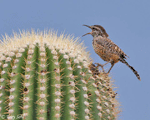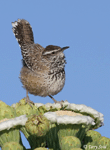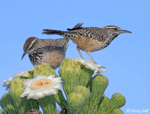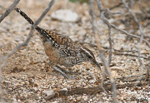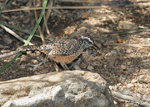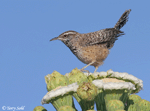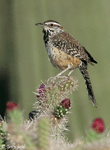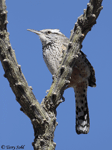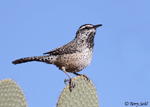| Length: 8.5 inches | Wingspan: 11 inches | Seasonality: Non-resident in South Dakota |
| ID Keys: Largest of wrens, bold white supercilium, long bill, spotted breast | ||
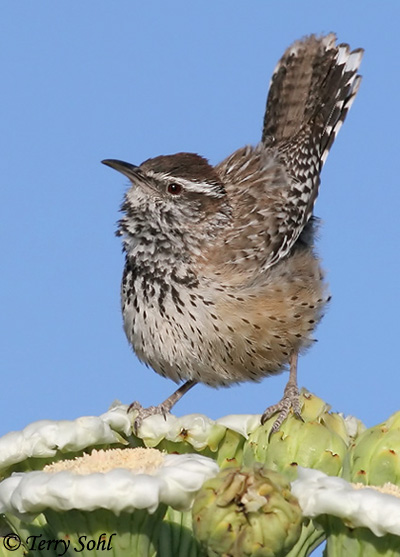 The
Cactus Wren is an unmistakeable and very noticeable bird throughout much of
its range in the southwestern U.S. and Mexico. Very bold and curious,
they can often be seen perched at the top of a cactus, calling or defending
territory. Like some other wrens, defending territory may also include the
puncturing of eggs of other species that are found nesting within an
established Cactus Wren territory. Well adapted to the dry climates
that it prefers, they rarely, if ever, directly drink water, instead
obtaining all water needs through the food they consume.
The
Cactus Wren is an unmistakeable and very noticeable bird throughout much of
its range in the southwestern U.S. and Mexico. Very bold and curious,
they can often be seen perched at the top of a cactus, calling or defending
territory. Like some other wrens, defending territory may also include the
puncturing of eggs of other species that are found nesting within an
established Cactus Wren territory. Well adapted to the dry climates
that it prefers, they rarely, if ever, directly drink water, instead
obtaining all water needs through the food they consume.
Habitat: Cactus Wren can be found in a variety of dry habitats, but are most common in desert regions of the Southwest, especially in areas where thorny cactus and shrubs provide nesting (and foraging) opportunities. They can also be found in other brushland and in suburban areas.
Diet: Diet is composed primarily of insects. They will also sometimes eat some fruits, nuts, and seeds, and occasionally small invertebrates such as small lizards.
Behavior: Very adaptable, curious, and aggressive. Cactus Wrens have learned to adapt to new foraging opportunities provided in suburban areas. Much of their foraging is done on the ground.
Nesting: Pairs of Cactus Wrens are likely mated for life. Pairs can be seen on territory throughout the year, even outside of the breeding season, grooming each other and often foraging together. Nests are typically built in a cactus or other thorny, protective plant, typically relatively low to the ground (below 12 feet). Both sexes construct the nest and take care of the young, although only the female incubates the eggs.
Song: Song of the cactus wren is a nonmusical low, harsh gurgling.
Migration: Non-migratory, considered a permanent resident throughout its normal range.
Interactive eBird Map: Click to access an interactive eBird map of Cactus Wren sightings
Similar Species: In range, generally distinctive compared to other wrens, when considering size, habits, and habitat.
Conservation Status: While Cactus Wrens are reasonably tolerant of human activity and have adapted to living in urban "desert parks", they have undoubtedly declined in parts of the Southwest due to habitat loss. California populations particularly have declined as coastal shrub/scrub habitat that they depend upon has disappeared. Texas populations have also evidently declined in recent decades.
Further Information: 1) WhatBird - Cactus Wren
2) Audubon Guide - Cactus Wren
3) Wikipedia - Cactus Wren
Photo Information: May 7th, 2008 - Outskirts of Tucson, Arizona - Terry Sohl
Additional Photos: Click on the images or photo names below for additional, higher-resolution photos of this species.
| Click below for a higher-resolution map |
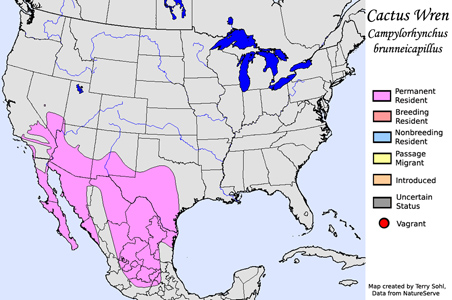 |
| South Dakota Status: Non-resident in South Dakota |
Additional Cactus Wren Photos
Click for a higher-resolution version of these photos
